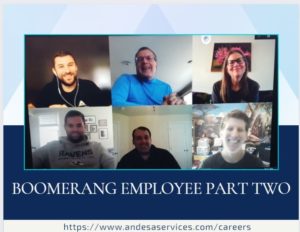The Boomerang Boom Part Two
As a recap from Part 1, we defined a boomerang employee as someone who leaves a company only to be rehired by that same company at a future date.
I also shared that most of the information in this 2 part blog came from a discussion with several Andesa employee-owners who navigated the successful boomerang experience. Anne, Bill, Bob, Greg and Matt are highly motivated team players who returned to Andesa with new skills to contribute to our success. They each shared their stories, insights, and advice with me. Some of their quotes are sprinkled throughout my takeaways from the conversation.
In Part 1 we identified the Pro’s of rehiring an employee:
- Familiarity minimizes guesswork for the hiring manager.
- Cost is an advantage often cited for the rehire.
- The returning employee also brings back new experiences, perspectives, and skills to share which could benefit the organization.
- Hiring someone back also serves as a testament to the company and its culture.
We also recognized some potential pitfalls:
- Before getting too far into the rehire cycle, the manager should assess the candidate across the team and organization.
- The manager and HR should collaborate before deciding to ensure they understand why the employee left in the first place.
And, we identified some process ideas for dealing with a boomerang situation:
- Keep the door open.
- Be intentional.
- Establish a criteria-based process for interviewing.
- Strive to keep the talent in the first place.
Part 1 of this blog offered advice primarily to employers. In this Part 2 of the blog, advice is offered primarily to the prospective boomerang employee.
Recommendations when departing
A 2016 study by the staffing company Spherion indicated that 40 % of employees would be willing to return to a previous employer. If you decide to leave a job, it’s important to end on good terms with your colleagues and employer.
Be clear why you’re leaving. Open honest communication with your manager helps establish credibility and professionalism. Make sure your reasons for departing are logical and not emotional. Have the conversation before you assume something can’t be done. If departure is still the pathway, make sure the explanation is clearly understood and leaves the door open to future possibilities should your circumstances or the company’s needs change. “If you’re thinking of leaving, go through the thought process of why you’re leaving. Don’t make a decision in the heat of the moment or when you’re in a bad place emotionally. There are a lot of companies who are willing to work with you and in many ways, but definitely have those conversations. Think it through.”
Don’t burn bridges. Life changes. How you depart and what you accomplish in the last two weeks will leave a lasting impression. Be hard working and ethical. Depart on good terms to provide future opportunities. It’s part of being a professional. “It’s not just about burning your bridges. I mean, I’m a professional, the people around me who I’ve worked with are professional. They all helped me and I don’t want to let them down as I’m departing.”
Recommendations while away
It’s unlikely an employee would consider a return to a company if they left due to a negative work experience or if they were dissatisfied with the organization. But what if it was for personal or professional growth opportunities where returning is not out of the realm of possibilities. What does one do in the interim?
Actively maintain the personal and professional relationships you established at the company. Boomerang employment is a growing trend. Technology and social media make it easier to stay in contact over time. Having the supportive network may come in handy. “I know that some who came back weren’t necessarily looking to come back. It’s just that we built those relationships, and we continue to foster the community on a personal level so that, when there was an opening, there were discussions.”
Don’t Fear the Door! A certain element of pride must be overcome to return to a former employer. As previously noted, there is a rising trend in boomerang employees and a diminishing stigma associated with the trend. But one’s own mindset still might be the biggest obstacle to exploring the possibilities. “I think the one thing that was the toughest is Don’t Fear the Door. If you feel you want to come back and that you didn’t leave on bad terms, Don’t Fear the Door. Just kind of push on it. I think the biggest fear is getting through your own mental fear of it. I think sometimes the fear may stop certain people to even get to the door.”
Tips for a successful return
The willingness to come back to a former employer and an actual return are two different things. A return indicates you left on good terms, are a valuable member of the team and that your old company wants you back. Rejoining an old company is a different experience than joining a new one so here are a couple of thoughts for consideration.
Don’t assume everything is how you left it, even if you’ve only been away a short time. Especially now, as the pandemic has impacted every company. Accelerated employee movement means familiar co-workers may no longer be around and new faces already fill those vacancies. Processes, systems, workflows, and culture have likely evolved. Take time to understand what has and hasn’t changed in the organization. “It’s getting integrated again. I was going to be on different carriers or projects. You’re going to have to expand a little and it hasn’t been the smoothest. It was awkward with the new hires. We had eight or ten people on the team but I didn’t know 20% of them. I was an outsider to them and yet an insider to everyone else.”
Prepare for the interview. It is a career move and you don’t know how the company will approach the hiring process. Don’t let personal comfort or a rosy memory cloud your evaluation. On the other hand, don’t assume familiarity guarantees an offer either. Be prepared. Validate if returning is the right move as you go through the process. “I didn’t approach it like it’s a done deal. I approached it as if I was interviewing for a new company. I took the interview process seriously. I thought about the questions I might ask if I were interviewing a returning employee and made sure I was prepared. I made no assumption that I’m a known quantity.”
Bring your “new you” to the new role. Because of familiarity, your honeymoon period will be short-lived. Lean on your prior knowledge and history with the firm while simultaneously taking advantage of the opportunity to raise ideas from the outsider’s fresh perspective. Apply or reaffirm the lessons you learned while away. “I view my leaving and coming back as a positive for me and a positive for Andesa. I have new skills and I bring them back and see where I can use them. I’m able to work on different teams. Some people leave companies to get different skills and then move to different areas when they come back.”
Many thanks to the group of Andesa boomerang employees for helping me change my perspective. I now think people who boomerang can be a smart move for both the employer and the returning employee provided both parties consider the ramifications and accomplish the return through a thoughtful process.
Do you have tales or viewpoints to add to this conversation? Leave us a message in the comments section.
Follow the Andesa Blog
"*" indicates required fields




